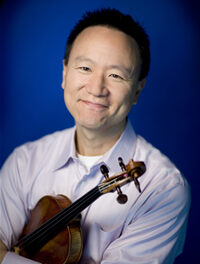If you didn’t get a box of chocolates for the holidays, you could have found a similarly tasty richness in the musical offering of the Four Seasons Chamber Music Festival‘s first concert of 2011. String quartets by Mozart and Schumann and a sublime reading of Dvorák’s Piano Quintet in A, Op. 81, filled the A.J. Fletcher Recital Hall at East Carolina University with gorgeous sounds.
Festival artistic director Ara Gregorian invited his new Daedalus Quartet colleagues back to Greenville to perform, and he and the other three players are forming a near-seamless collaboration. Gregorian and Min-Young Kim share the violin roles, Jessica Thompson plays viola, and Raman Ramakrishnan plays cello. For the Dvorák quintet, they were joined by new ECU keyboard faculty member Benjamin Hochman.
Mozart’s 23rd string quartet (in F, K.590, often called the “Prussian No. 3”) has quite an engaging opening allegro moderato movement with a nice three-note ascending figure that dominates the scoring in both solo and ensemble playing. Ramakrishman’s cello was elegant throughout, and Gregorian in the first violin chair and Ramakrishnan also engaged in a playful dialogue. The second movement, an allegretto, was built on a lovely seven-note theme with variations and some wonderful inner harmonies not unlike the kind that Schubert used some years later.
The third Minuetto movement had an elegant if slightly subdued dance feel. In fact, the entire quartet, taken as a whole, seemed more subdued than usual for Mozart, lacking (but not in a negative way) some of the liveliness and humor one often hears in his music. The program notes point out that Mozart was ill and had nearly exhausted his financial resources when he undertook the Prussian quartets for the king, in hopes of a commission (Mozart died just before the quartets were released). Nevertheless, the minuet is quite lovely, and the final allegro movement does have moments of both energy and delicacy, along with forceful ensemble passages, before coming to a close with an unexpectedly quiet and un-climactic ending.
As lovely and well played as the Mozart quartet was, the evening belonged to Schumann and Dvorák. The Schumann String Quartet in A-minor, Op. 41, No. 1, often sounded as if played by a chamber orchestra, and the Dvorák quintet contained a musical and emotional stateliness reminiscent of chamber music by Brahms, contrasted against some lively Czech dances.
Schumann’s quartet is filled with gorgeous passages, not to mention sections of dramatic tension, and the Daedalus Quartet brought great skill and emotional intensity to the piece. Whether in full ensemble, or with a solo instrument playing against the remaining trio, the musicians gave a splendid reading. The piece itself provided some interesting contrasts in tempi — sharply delineated slow-fast-slow-fast rhythms by movement — and yet the players always seemed to be in perfect timing with each other, especially in the faster passages. And the sound was quite impressive. Kim, in the first violinist’s seat, brought a warm and beautiful tone during the entire piece; Thompson’s viola provided richness in the lower register between the two violins and the cello.
The opening musical progression of first violin-second violin-viola-cello in the first introduzione: andante movement is countered by an almost mirrored progression later in the movement (viola-cello-second violin-first violin), and Schumann also includes brief fugue-like passages. The second movement, scherzo: presto, is played with breakneck speed that could accompany a horserace; in fact, one could almost envision the Lone Ranger riding Silver as accompanied by the William Tell Overture. Ramakrishnan, Thompson and Gregorian opened the third adagio movement and later had a lovely melody line played over Kim’s plucked violin, and the duet playing by Gregorian and Kim was elegant. Ramakrishnan’s cello provided a prominent drone to accompany the energetic passages in the final presto movement.
The Dvorák quintet, last played here in January 2007, is simply a top-drawer piece, more than 40 minutes of outstanding music-making. Two interesting musical themes emerge: in the first allegro movement, the solo cello opens with a line that recalls “Shall We Gather at the River?” and this line repeats a few times before the movement ends. And the second movement’s primary piano line is remarkably similar to the ballad “Nature Boy,” made popular by Nat King Cole in the late 1940s. Regardless of musical reminders, the quintet deserves its place among the most popular of classical chamber music compositions.
Much of the opening movement could easily have been considered homage to Brahms in both its harmonic development and its intense yet refined and stately nature. The movement included nice duet passages played by Hochman and Thompson and by Gregorian and Ramakrishnan. The lovely melancholy theme of the second dumka: andante con moto movement received wonderful playing from Hochman, and Thompson’s viola provided the prominent lead voice throughout the movement, including passages played over the remaining string trio. She also had nice duet lines with Gregorian.
The third scherzo (furiant) movement opens with a sprightly dance but shifts to a softer, more relaxed tempo, and this movement gives the impression of a warm, early summer evening. The intensity level picks up considerably for the final allegro movement, but it, too, has a dance-like feel, at least initially, along with a brief fugue and a noticeable return to some of the Brahmsian stateliness of the first movement. In both the third and fourth movements, the music often bounces right along, propelled by the piano, and Hochman never faded into the background.
As usual, another fine performance by Gregorian and friends, and the Schumann quartet and Dvorák quintet would be worthy inclusions on a “Four Seasons Chamber Music Festival Greatest Hits” recording.











